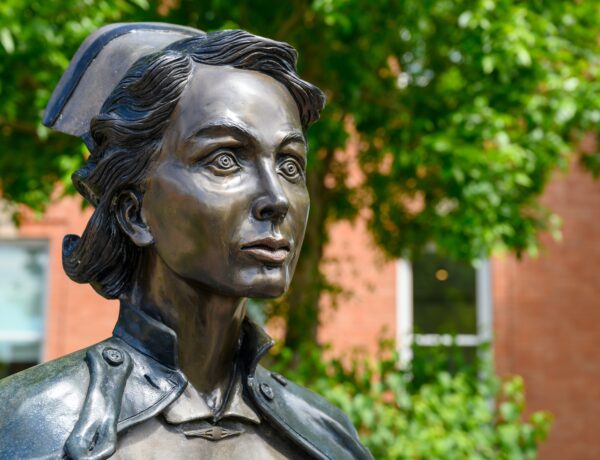Let’s all rise and give thanks to William A. Lawrence, a dairyman, late of New York State. Lawrence was an American cheese-man who had the foresight and creativity to add some cream to a centuries-old cheese recipe which magically produced the basic ingredient for American-style cheesecake: cream cheese.
I was first introduced to the ambrosia known as cheesecake in 1972 when my father purchased the 12-volume set of Woman’s Day Encyclopedia of Cookery. Volume 3, with “Cat-Cre” on the spine contained the magic recipe for Secret Harbor Cheesecake. These cookbooks were purchased at a time in our family life when my mother and father, both of whom were talented cooks, decided to branch out and break from the traditional foods that up until then had adorned our table.
William Lawrence was a farmhand in New York State in the mid-1800s and he started a cheese business in 1861. Ten years later, wanting to expand his business, he purchased a cheese factory that produced Neufchâtel cheese.
Like William Lawrence, my parents came from humble beginnings. Mother learned how to cook, and more importantly bake, from her foster mother. Tuesdays became baking day at our home and mom would turn the kitchen into a bakery of Willy Wonka proportions. Homemade breads, cookies, cakes, squares, pies and everything sweet would fill the counter and our bellies. Dad learned to cook at his grandparents’ stove. Large, simmering pots of oregano-infused tomato sauce with meatballs the size of your fist, fried potatoes with sweet green peppers, chicken slowly roasted with rosemary, and spicy sausage, were all served with a chorus of Tony Bennett crooning in the background. Food was basic and plentiful in our house.
Neufchâtel is a type of cheese that has been produced in the Normandy region of northern France since the 6th century and although we must pay it homage as being the founding father of American-style cheesecake, we can skip the details about it being slightly crumbly and mold-ripened. Mr. Lawrence, or William as I now call him in my dreams of cheesecake-land, decided one day that he would add just a little bit extra cream to the process of making Neufchâtel, accidentally producing cream cheese. The rest, cheesecake lovers, is history.
You could say the same about our family’s foray into the culinary arts. To be fair, and to keep the family history straight, my older sister Linda was the original food experimenter in our clan. In the late 1960s, 16-year old Linda was the proud owner of Julia Child’s Mastering the Art of French Cooking and we became the guinea pigs for her creations. Some of her dishes were memorably uneatable, but she pushed us to the brink of trying new things. By 1972, our family was living in southern West Germany. Our proximity to France, its restaurants and fresh garlic, was the impetus that pushed our family dining over the precipice and onto a wild roller-coaster ride of gastronomical delights.
The chemistry to produce something as simple and beautiful as cream cheese is hard to comprehend for someone who barely passed high school science. There is talk of protein molecules, negative surface charges, surfactants, micelles, fat, and emulsion. Lactic acid bacteria are added to milk and it is then fermented to a certain temperature. Get it? Trying to understand the complicated chemistry of producing cheese makes it easier to understand how William may have added a wee bit too much cream one day, resulting in this now-famous product. He started marketing his mistake as “Neufchâtel & Cream Cheese.”
Imagine cooks discovering cream cheese for the first time back in the 1870s. It might have been like our family’s discovery of fresh garlic in 1972. We made regular Friday evening visits to small French towns in Alsace, mere kilometers across the Rhine River from our home in the Black Forest near Hugelsheim, where we discovered quaint, centuries-old restaurants. A favourite was the Auberge à l’Agneau, a small, intimate eatery on the dark, main street of Roppenheim, where the food was served family-style on locally made, thick pottery plates. Or Le Chat Noir, in Neuhaeusel, a few towns away where the owners would regularly greet us like long lost cousins.
Our family’s education in the appreciation of real food began at the school I like to call the Academy of Small Town, French Cuisine. Freshman lessons that brought us to our knees in thanks included an introduction to fresh garlic, onion soup smothered in sharp Gruyère cheese, gently sautéed meats, and fresh vegetables perfectly prepared. We moved on to sophomore lessons in smooth cream sauces covering veal that would melt in your mouth, potatoes the way God meant them to be served, and salads with dressings concocted from the simplest of ingredients. We graduated as seniors when we were eagerly tearing off bits of crisp baguette to sop up the bubbling, hot garlic butter that smothered delicious escargots (snails), and nearly fainted at the aroma coming from the dish of Cuisses de Grenouilles Provençal (frog’s legs).
These gastronomy lessons produced an eager student in my mother, who wanted to duplicate everything she tasted, so it was a win-win situation for everyone. Using garlic in gargantuan amounts became the new norm in our home. A large vat of fresh butter, infused with chopped, fresh garlic and parsley resided in the refrigerator. Instead of using plain butter to fry your morning eggs, we used the garlic butter. Something quick for dinner? Maybe a chicken breast stuffed with Swiss cheese and some of that garlic butter. The kitchen became mom’s science laboratory where she experimented with different recipes, trying to duplicate what we had eaten at the restaurants. Dad on the other hand needed to learn from cookbooks, and that’s where the Woman’s Day Encyclopedia of Cookery comes in.
Food historians claim that cheesecake is almost 4,000 years old. Cheese molds were excavated on the Greek Island of Samos and there is evidence that cheesecake in its earliest form (cheese, flour, and honey) was served to athletes at the Olympic games and at Greek weddings. Greek writer Athenaeus left a recipe dated 230 BCE that instructed the cook to “pound the cheese until it is smooth and pasty, mix the pounded cheese in a brass pan with honey and spring wheat flour, heat the cheese cake in one mass, allow it to cool, then serve”. Sweetly simple.
The recipes set out in the Woman’s Day books were simple and classic. Volume 1 covered Abalone to Bean Sprouts. In the section on “Baking”, readers were given advice such as “It pays to know your oven” and golden nuggets like “Tips for Picture-Perfect Pies and Cakes”. Dad worked his way through the volumes and for several, memorable decades, he settled on Volume 3 that contained not only cheesecake recipes, but how to prepare Chinese food dishes. We were in heaven.
Weary, nearly beaten Roman armies heading home to Italy after conquering Greece in 146 BCE, brought with them something resembling Athenaeus’ recipe for cheesecake, tucked inside Cato the Elder’s shield (that’s my version of history). Cato the Elder, a real Roman soldier, fought against Hellenistic influences, wanting to preserve Roman culture but he clearly was not immune to certain Greek traditions – notably cheesecake. He was also a senator, farmer, historian and writer, and a recipe for cheesecake (called Libum) was included in his “Di Agri Cultura” textbook. This recipe was identical to the Greek’s, except Cato added eggs to his version – a brilliant addition. Libum became a special cake in Roman culture, offered to the household gods or during sacrificial rituals. The ancients understood the magic of mixing cheese with a sweetener.
Like adding toasted, slivered, buttered almonds to a basic dish like green beans – Haricots verts aux amandes– an inspired way to make vegetables palatable. Or the delectable simplicity of raw, shredded carrots, dressed with Dijon mustard, olive oil and lemon juice, with fresh parsley sprinkled on top. These were some of the simple side dishes we were served at the small French restaurants. Or, cookbook discoveries such as – wait for it – garlic and soy sauce added to beef – Niu Ju Chin Jow (beef and green peppers). 1960s Sunday dinners in our home had often been centered around roast beef, which was roasted to shoe leather consistency because we didn’t know any better and could only afford cheap cuts of meat. So, the introduction of Beef and Green Peppers, page 403, Volume 3, had our family following the Roman tradition of making offerings to the household gods in thanks.
The evolution of cheesecake continued over the centuries in Europe with each culture experimenting with ingredients. The British – who are not historically known as culinary geniuses – had a version by Henry VIII’s chef where he soaked the cheese in milk for three hours before straining it and then adding the key ingredients of eggs, butter and sugar. Around the 18th century, European cookbooks showed yeast being removed from the recipe and well-beaten eggs being used to make the cake rise. This is when it started becoming a dessert treat and would be the precursor to the American versions we love today. Many of these European recipes made their way to North America in immigrants’ suitcases and memories.
The evolution of our family’s education in the culinary arts was an adventure with everyone playing their part – some of us eager to be creative in the kitchen and others patiently waiting at the dining table for the family chef’s latest concoction, napkin in our lap, knife and fork at the ready. The early years of my life had included baked, sweet treats from that Willy Wonka bakery of my mom’s. But eventually our family’s education at the Academy of Small Town, French Cuisine exposed her inner Julia Child and before you knew it, we were being treated to La Crêpes Suzettes flambéed in Grand Marnier, Cherries Jubilee stewed in brandy and served over homemade vanilla ice cream, Baked Alaska, and yes, cheesecake.
The preface to the section on Cheesecake in Volume 3 was written by James A. Beard – a renowned American chef, author, teacher and TV personality who was a champion of American cuisine. In the introduction, Beard starts by wanting to honour the inventor of cheesecake but can’t because “no one has the faintest idea who he, or she, was. It might have been an ancient Greek, for they made cheesecakes of a simple kind”. Beard chose and included nineteen recipes that he collected from “across the country and Europe . . . some are firm and rich; others are light, almost like a soufflé in texture; others are creamy.”
The Secret Harbor Cheesecake recipe, now a family classic, originated at the Secret Harbor Restaurant in Los Angeles, and its recipe calls for one pound of cream cheese. Cream cheese is the secret ingredient in many American-style cheesecakes where Italians use ricotta cheese, Greeks use mizithra or feta, Germans prefer cottage cheese, and Japanese use a combination of cornstarch and egg whites. New York, Chicago, San Francisco, St. Louis and other American cities have their own special versions of cheesecake but the one thing they have in common is cream cheese. Thank you, William A. Lawrence.
The battered, well-used, 12 volumes of the Woman’s Day Encyclopedia of Cookery now sit beside Julia Child’s recipes and a treasure trove of other cookbooks in Linda’s large, farmhouse-style kitchen.



